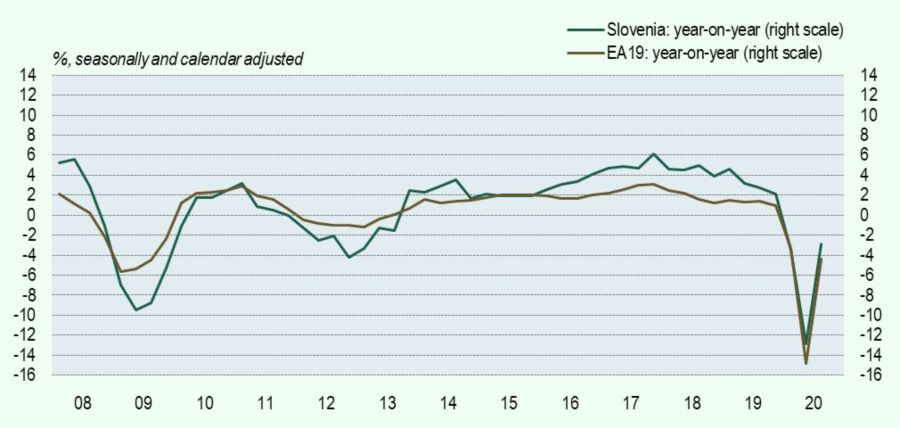After the lifting of the most stringent containment measures, economic growth in the third quarter of this year rose sharply as expected. The vast majority of sectors saw an improvement, although the strength of the recovery began to weaken even over the course of the quarter. Banka Slovenije expects there to be a significant renewed decline in activity in the final quarter of this year, amid the reimposition of the lockdown, albeit less pronounced than during the first wave of the epidemic.
According to figures from the Statistical Office, economic growth rebounded as expected in the third quarter (by 12.4%) as the most stringent containment measures were lifted. The rate was comparable to that in the euro area overall (12.6%). GDP was nevertheless down 2.6% in year-on-year terms.
The majority of sectors saw a high level of recovery in the third quarter, although there was great variation between them (as was typically the case in most other euro area countries). The situation in construction was good; this was attributable not only to the strengthening of residential construction, but in particular to increased government investment activity in the form of civil engineering work. The normalisation of the situation in supply chains and strengthening foreign demand also brought a considerable improvement in industry. Of the major sectors, only the manufacture of basic metals was still facing a deep contraction, while just over two-thirds of manufacturing sectors exceeded last year’s level of output. The rebound in domestic private consumption meant that real retail turnover surpassed last year’s level (excluding fuel sales). As expected, business conditions remained most challenging in services that rely on social contact or on international tourism.
The recovery began to stall even in the third quarter, before the economy hit a sharp renewed downturn late in the year with a new wave of the epidemic and the reimposition of containment measures. Banka Slovenije is forecasting the economy to contract again in the final quarter of this year, albeit by less than in the second quarter.
On this occasion the deepening crisis is mainly in services. Banka Slovenije’s assessment is that in this segment of the economy, which was hit hardest by the crisis, there is a high probability of a lasting crisis. The services hit hardest by the containment measures accounted for approximately 22% of jobs and 20% of value-added in the domestic economy before the crisis, and 25% and 19% respectively in the euro area overall.
By contrast, manufacturing firms remained optimistic in their assessments of demand in November. This is attributable to the preservation of supply chains, better preparedness for doing business during the epidemic, and stronger foreign demand than in the first wave on account of renewed economic growth in China and encouraging economic figures for the US. China and the US accounted for 23% of the euro area’s merchandise exports before the crisis. Firms in German industry also remained relatively optimistic in November.
Figure 1: Year-on-year economic growth in Slovenia and the euro area
Sources: SORS, Eurostat, Banka Slovenije calculations

